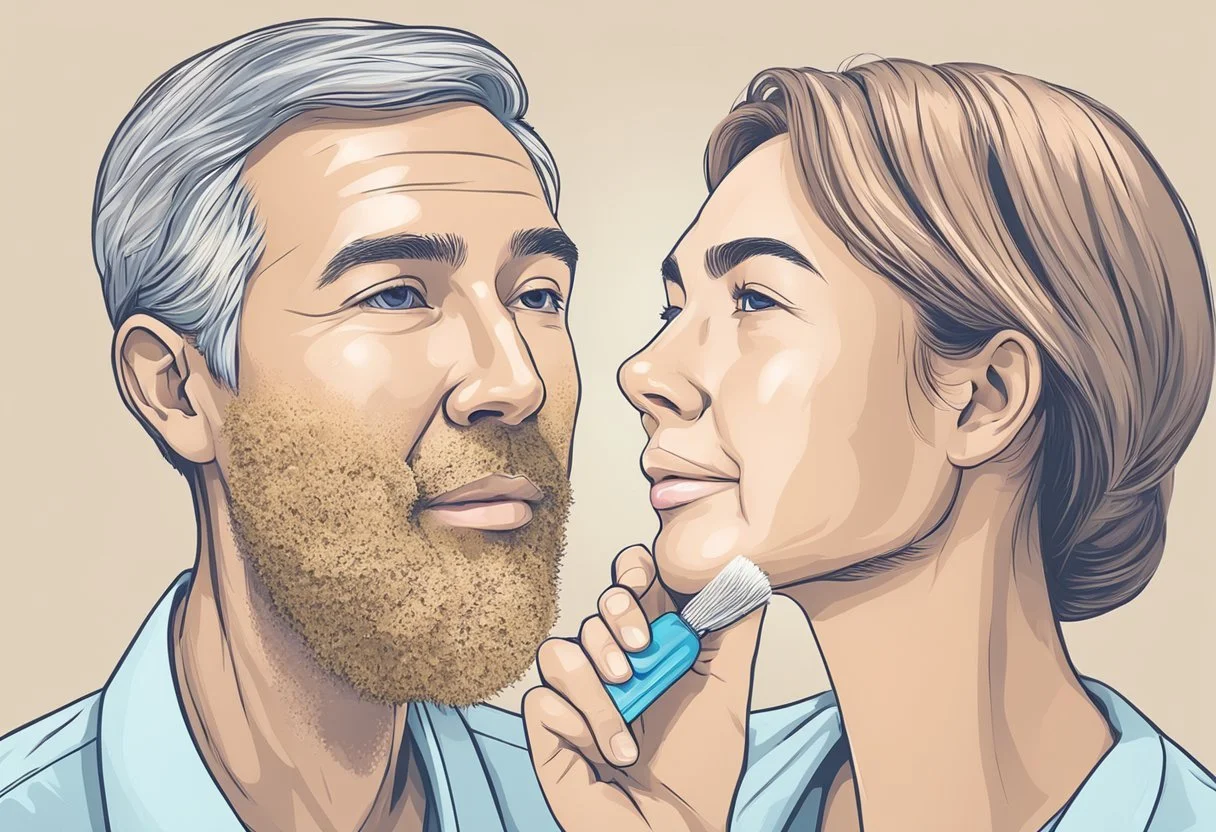Dry Face Brushing
Your Guide to Radiant Skin
This article is part of our series on Natural Health
Discover > Natural Health > Dry Face Brushing
Dry face brushing is an emerging skincare practice that has recently gained attention in the beauty and wellness industry. The technique involves using a soft-bristled brush to gently exfoliate the facial skin, promoting a smoother, healthier-looking complexion. With roots in traditional self-care routines, this form of dry brushing is garnering interest from those seeking a natural and beneficial treatment for the skin.
The practice of dry face brushing offers several potential benefits, including the removal of dead skin cells, improved circulation, and support for an even skin tone. By unclogging pores and stimulating blood flow, this method can potentially help the skin appear fresher and more radiant. In addition, dry brushing is known for its simplicity and cost-effectiveness, making it an accessible solution for many individuals looking to improve their skincare routine.
While incorporating dry face brushing into one's daily regimen, it is essential to follow proper techniques, use appropriate tools, and pay close attention to the individual's skin type. When applied with care and consistency, dry face brushing can contribute to a revitalized and beautiful complexion for all to enjoy.
Understanding Dry Face Brushing
Dry Brushing Origins
Dry face brushing finds its roots in Ayurvedic medicine, an ancient holistic healing system from India. This practice has been used for centuries to promote healthier skin and improve overall circulation.
The Dry Brushing Process
To begin dry brushing, you'll need a brush with natural bristles and a long handle for ease of use. Start at your chin, using light pressure and gentle circular motions to brush the skin. Work your way up to your neck and décolletage, being careful not to cause any discomfort or irritation.
It's important to maintain a consistent pressure throughout the process, as applying too much force can damage the skin. Adjust the pressure as needed to ensure a comfortable and effective experience.
Choosing the Right Brush
When selecting a dry brush for your face, consider the following features:
Bristles: Opt for natural bristles, as they are less abrasive on the skin. Synthetic bristles may be too harsh and could cause irritation.
Handle: A long handle will make it easier to reach all areas of your face, especially around the neck and décolletage. It also allows for a more comfortable grip.
Manufacturer: Choose a reputable manufacturer that adheres to high-quality standards, ensuring you get a durable and effective dry brush.
Remember that dry face brushing can be a beneficial addition to your skincare routine. However, always listen to your skin and adjust the frequency, pressure, and technique if needed.
Benefits of Dry Face Brushing
Exfoliation and Skin Appearance
Dry face brushing is a skincare method that promotes exfoliation, which helps in removing dead skin cells and flaky skin. This technique is an excellent addition to your skincare routine, as it is known to enhance the overall appearance of the skin. One of the benefits of exfoliating includes a smoother and more radiant complexion after regular use.
Another advantage is that it aids in unclogging pores, preventing potential skin issues, such as breakouts or blackheads. Furthermore, gentle dry brushing can promote better product absorption, ensuring your skin gets the full benefit from your other skincare items.
Circulatory and Lymphatic Benefits
The practice of dry face brushing not only benefits your skin but also has several effects on your circulatory and lymphatic systems. Through gentle, circular motions, dry brushing serves as a massage for your face. These movements help increase blood circulation to the skin, delivering essential nutrients and improving overall skin health.
Additionally, dry face brushing assists in stimulating the lymphatic system, promoting lymphatic drainage. This process helps eliminate toxins from the body and can lead to a natural energy boost when regularly practiced.
Potential Effects on Cellulite and Fat
Although more research is needed, some people believe that dry face brushing may have an impact on the appearance of cellulite. The technique's massaging motion is thought to improve circulation and blood flow, which can contribute to plumping the skin and reducing the visibility of cellulite.
In summary, dry face brushing is a holistic skincare method with several benefits, including exfoliation and skin appearance improvement, circulatory and lymphatic system enhancement, and potential effects on cellulite and fat.
How to Dry Brush at Home
Preparation for Dry Brushing
Before you begin dry brushing, it's important to gather the necessary materials and set up your space. You will need a dry brush specifically designed for the face, preferably with a long handle to reach all areas easily. It's best to perform this technique in the bathroom near a shower or bath so you can cleanse your face afterward. Have a clean washcloth and your favorite moisturizer, serum, or lotion on hand.
Executing the Dry Brushing Technique
To start dry brushing, make sure your face and dry brush are both clean and dry. Hold the brush with a comfortable grip and begin brushing your face in gentle, circular motions. Start at the center of your face, working your way outward and upward. Be mindful of the pressure you apply as you don't want to irritate your skin. The goal is to stimulate lymph flow and exfoliate without causing discomfort.
Post-Brushing Skincare Steps
After you've finished dry brushing your entire face, it's time to hop into the shower to rinse away any dead skin cells and impurities. Use a gentle cleanser and your washcloth to further cleanse your face. Once you've rinsed off and patted your face dry, apply a hydrating moisturizer, serum, or lotion to replenish and nourish your skin. This step is crucial as it helps seal in moisture and prevents your skin from feeling tight or dry.
Maintaining Your Dry Brush
To keep your dry brush in good condition, clean it regularly with soap and water. Gently scrub the bristles and rinse thoroughly, then squeeze out any excess water. Allow the brush to air dry completely to prevent any mildew or bacteria growth. By properly maintaining your dry brush, you can ensure it stays effective and hygienic for continued use.
Precautions and Possible Side Effects
Sensitive Skin and Irritations
Dry face brushing can lead to sensitive skin, redness, and irritation in some individuals. It is important to choose a brush with soft bristles and to brush gently to minimize these effects. To avoid inflammation and irritation, do not brush too often – limit face brushing to once or twice per week. People with pre-existing skin conditions such as eczema, psoriasis, rosacea, or acne should be especially cautious, as dry brushing might aggravate these conditions.
Awareness of Moles and Warts
It is essential to avoid brushing over moles and warts due to the risk of damaging these sensitive areas. Damaging moles can make it difficult to monitor changes in their appearance – which is important for detecting potential skin cancer. Similarly, spreading the virus that causes warts can lead to more warts. While brushing, pay close attention to any such areas and navigate around them.
Special Considerations for Specific Conditions
Individuals with certain skin conditions should take additional precautions when dry face brushing:
Eczema and psoriasis: These conditions often cause inflamed patches of skin. Avoid brushing these areas to prevent further irritation.
Rosacea: The facial redness and inflammation characteristic of rosacea can be worsened by dry face brushing. It is best to consult with a dermatologist before starting a dry brushing routine.
Acne: Aggressive dry brushing can spread bacteria and make acne worse. Limit brushing to once per week, and use a clean, soft-bristled brush.
In all cases, it is important to consult a dermatologist before incorporating dry face brushing into a skincare routine, especially for those with pre-existing skin conditions. They will provide guidance on personalized practices that will minimize the risk of side effects and help achieve the desired results.
Scientific Evidence and Dermatologists' Views
Dry Brushing and Scientific Research
There is limited scientific evidence to support the claimed benefits of dry face brushing. Most of the available research on skin brushing focuses on cellulite reduction and lymphatic drainage, not specifically on the face. Additionally, the studies conducted on cellulite have shown mixed results.
Dermatologists tend to be cautious about recommending dry face brushing, as the exfoliating effects can lead to skin irritation and damage. The American Academy of Dermatology Association (AAD) recommends gentle exfoliation for facial skin, rather than more abrasive methods such as dry face brushing.
Conclusion: Incorporating Dry Brushing into Your Routine
Incorporating dry brushing into one's daily skincare routine can offer numerous benefits. To make it a regular habit, it is best to integrate it into one's morning routine, before taking a shower or bath. This allows the individual to cleanse the skin after brushing, removing dead skin cells and impurities.
Dry brushing should ideally be followed by a moisturizer application to ensure the skin remains well-hydrated. By consistently including dry brushing in the skincare routine, one may notice improved skin texture and appearance over time.
Natural Health Solutions for Personal Care and Wellness
Natural health practices can provide a range of benefits for personal care and wellness. Foot scrub recipes can be made with natural ingredients like sugar, salt, and essential oils to provide a natural and effective solution for dry and cracked feet. These ingredients can be mixed together and used to exfoliate and moisturize the feet for a natural and non-toxic alternative to traditional foot scrubs.
Affirmations from Louise Hay can be a powerful tool for promoting positive thinking and self-love. Louise Hay's affirmations focus on cultivating self-acceptance, forgiveness, and gratitude, and can be a helpful tool for reducing stress and promoting overall well-being.
Home remedies for constipation during pregnancy can include natural solutions like drinking plenty of water, eating fiber-rich foods like fruits and vegetables, and getting regular exercise. Certain herbs like ginger and dandelion root can also help to promote healthy digestion and reduce constipation.
Herbal flowers like lavender, chamomile, and rose can be used to make natural remedies like teas, tinctures, and essential oils that can help to promote relaxation and reduce stress. These herbs can also be used in personal care products like soaps and lotions to provide a natural and soothing fragrance.
By incorporating natural health practices into your daily routine and making healthy choices for personal care and wellness, you can support your overall health and well-being in a sustainable and holistic way. It's important to do your own research and consult with a healthcare professional before using any new remedies or making significant changes to your diet or lifestyle.
#dry skin #dry brushes #facial dry brushing #body brushing #soft natural bristles #stimulate lymphatic drainage #dry brush your face #healthy skin #facial brush




